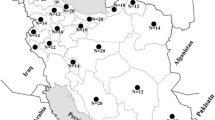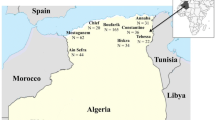Abstract
Seven microsatellite loci were evaluated to compare the allele pool of Primorsky honeybee population (n = 90), which was introduced into the Novosibirsk region (south-western Siberia), with the populations of Middle Russian (n = 191, A.m. mellifera), Mountain Grey Caucasian (n =113, A.m. caucasica), Carniolan (n = 61, A.m. carnica) and Carpathian (n = 184, A.m. carpatica) races. The degree of genetic differentiation in Novosibirsk population using a variety of criteria (Fst, Rst (AMOVA), Nei genetic distances) was evaluated.
Similar content being viewed by others
References
Engel, M.S., The taxonomy of resent and fossil honeybees (hymenoptera: Apidae; Apis), J. Hym. Res., 1999, no. 8 (2), pp. 165–196.
Alpatov, V.V., Porody medonosnoi pchely (The Breeds of the Honeybee), Moscow, 1948.
Ganaev, A.I. and Smirnov, V.M., Pchelovodu Dal’nego Vostoka (Manual for the Far East Beekeepers), Vladivostok: Dal’nevost. Izd., 1971.
Gubin, V.A., Origin of Ukrainian bees, Pchelovodstvo, 1975, no. 5, pp. 24–25.
Davydenko, I.K., Protection of Ukrainian bees, Pchelovodstvo, 1977, no. 3, pp. 23–24.
Ruttner, F., Biogeography and taxonomy of honeybees, Berlin: Springer, 1988.
Krivtsov, N.I., The reports of the Far East scientists about the bees, Pchelovodstvo, 2004, no. 10.
Afinogenov, L.Z., Morphometric and commercially useful features of Far East bees introduced to Western Siberia, Extended Abstract of Cand. Sci. (S-kh.) Dissertation, Novosibirsk: Novosib. Zon. Plodovo-Yagodnaya Opyt. Stantsiya, 2008.
Smith, D.R., African bees in the Americas: insights from biogeography and genetics, Trends Ecol. Evol., 1991, vol. 6, pp. 17–21.
Franck, P., Solignac, M., and Cornuet, J.M., Molecular confirmation of a fourth lineage in honeybees from the Near East, Apidologie, 2000, vol. 31, pp. 167–180.
Estoup, A., Garnery, L., Solignac, M., and Cornuet, J.M., Microsatellite variation in honeybee (Apis mellifera L.) populations: hierarchical genetic structure and test of the infinite allele and stepwise mutation models, Genetics, 1995, vol. 140, pp. 679–695.
Canovas, F., de la Rua, P., Serrano, J., and Galian, J., Microsatellite variability reveals beekeeping influences on Iberian honeybee populations, Apidologie, 2010, vol. 8(19), pp. 17.
Zinovieva, N.A., Harzinova, V.R., Logvinova, T.I., Gladyr’, E.A., Sizareva, E.I., and Chinarov, Yu.I., Microsatellite profiles as criteria for confirmation of breed purity and for evaluation of heterogeneity degree of parents’ pairs in pig breeding, S.-Kh. Biol., 2011, no. 6, pp. 75–79.
Zinovieva, N.A., Popov, A.N., Ernst, L.K., Marzanov, N.S., Bochkarev, V.V., Strekozov, N.I., and Brem, G., Metodicheskie rekomendatsii po ispol’zovaniyu metoda polimeraznoi tsepnoi reaktsii v zhivotnovodstve (Methodological Recommendations for Implementation of Polymerase Chain Reaction Method in Animal Husbandry), Dubrovitsy, 1998.
Paetkau, D., Slade, R., Burdens, M., and Estoup, A., Genetic assignment methods for the direct, real-time estimation of migration rate: a simulation-based exploration of accuracy and power, Mol. Ecol., 2004, vol. 13, pp. 55–65.
Weir, B.S. and Cockerham, C.C., Estimating F-statistics for the analysis of population structure, Evolution, 1984, vol. 38, pp. 1358–1370.
Slatkin, M., A measure of population subdivision based on microsatellite allele frequencies, Genetics, 1995, vol. 139, p. 1463.
Nei, M., Tajima, F., and Tateno, Y., Accuracy of estimated phylogenetic trees from molecular data, J. Mol. Evol., 1983, vol. 19, pp. 153–170.
Pritchard, J.K., Stephens, M., and Donnelly, P., Inference of population structure using multilocus genotype data, Genetics, 2000, vol. 155, pp. 945–959.
Raffaele, D.O., Alberto, M., Marco, L., and Robin, F.A.M., Genetic characterization of Italian honeybees, Apis mellifera ligustica, based on microsatellite DNA polymorphisms, Apidologie, 2007, vol. 38, pp. 207–217.
Author information
Authors and Affiliations
Corresponding author
Additional information
Original Russian Text © N.A. Zinovieva, V.A. Soloshenko, M.S. Fornara, K.S. Shatokhin, G.I. Kharchenko, A.V. Borodachev, V.I. Lebedev, E.A. Gladyr, G.M. Goncharenko, 2013, published in Doklady Rossiiskoi Akademii Sel’skokhozyaistvennykh Nauk, 2013, No. 3, pp. 40–43.
The article was translated by the author(s).
About this article
Cite this article
Zinovieva, N.A., Soloshenko, V.A., Fornara, M.S. et al. Genetic differentiation of the Novosibirsk population of Primorsky honey bee. Russ. Agricult. Sci. 39, 346–349 (2013). https://doi.org/10.3103/S1068367413040241
Published:
Issue Date:
DOI: https://doi.org/10.3103/S1068367413040241




